Report on Principles of Administration for Marriott Organization
VerifiedAdded on 2020/06/06
|13
|3121
|173
Report
AI Summary
This report provides a detailed analysis of the principles of administration, focusing on various aspects of office management and organizational operations. It begins by exploring the legal requirements associated with managing office facilities, including employment contracts and confidentiality. The report then delves into typical office services, establishment of management procedures, and the importance of managing office resources efficiently. Techniques for monitoring and managing work flows, as well as support and welfare facilities for workers, are also discussed. Furthermore, the report examines the legal obligations of employers and individual responsibilities for maintaining health and safety in the workplace, including accident and emergency procedures. The report also covers the purpose and legal implications of meeting minutes, along with the importance of accuracy and what should be included in different types of meeting minutes. Features and purposes of formal and informal meetings, roles and responsibilities of the chair and others in meetings, and techniques to facilitate meetings are also analyzed. Finally, the report explores the use of targets and budgets to manage workloads, techniques for allocating work to team members, quality management techniques, and event planning, providing a comprehensive overview of key administrative principles.
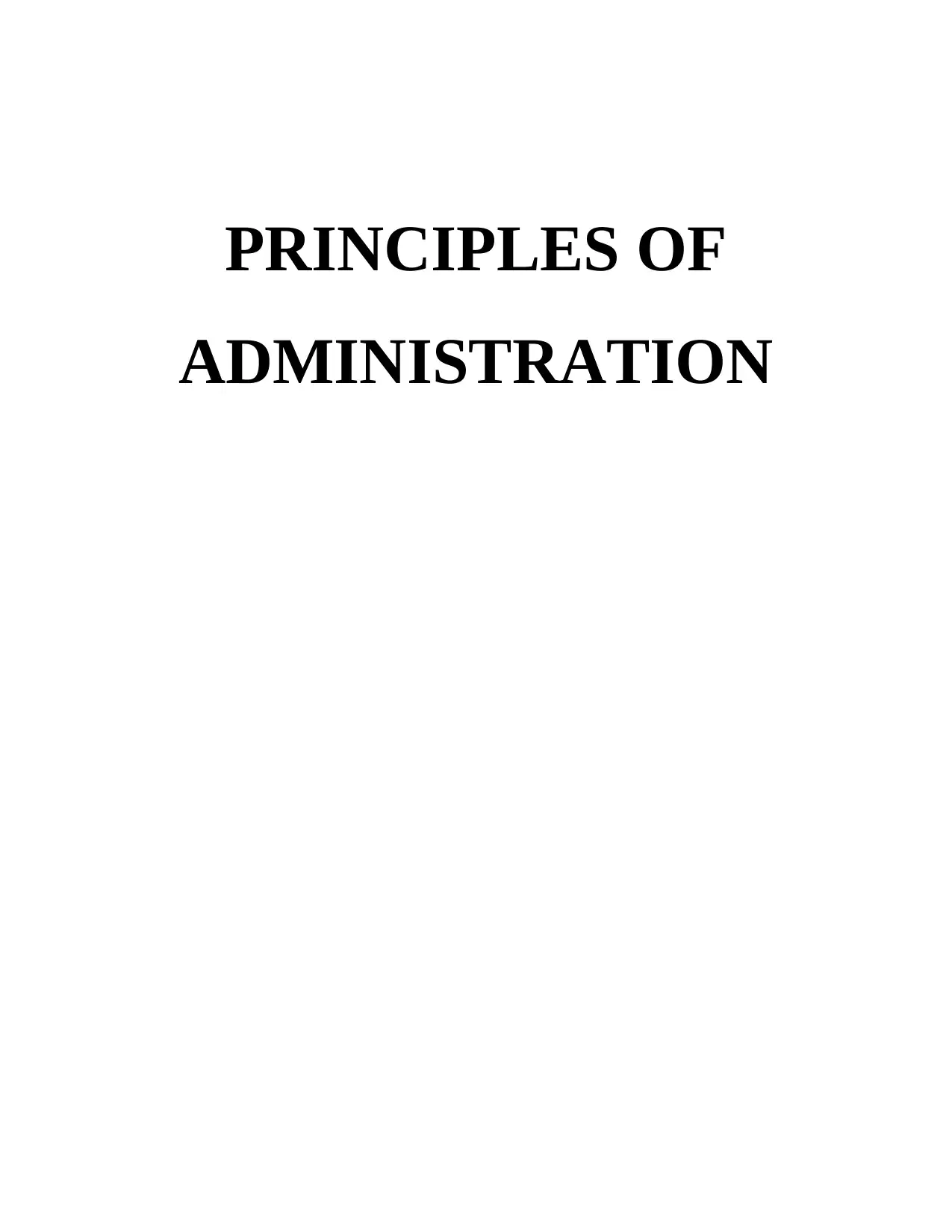
PRINCIPLES OF
ADMINISTRATION
ADMINISTRATION
Paraphrase This Document
Need a fresh take? Get an instant paraphrase of this document with our AI Paraphraser
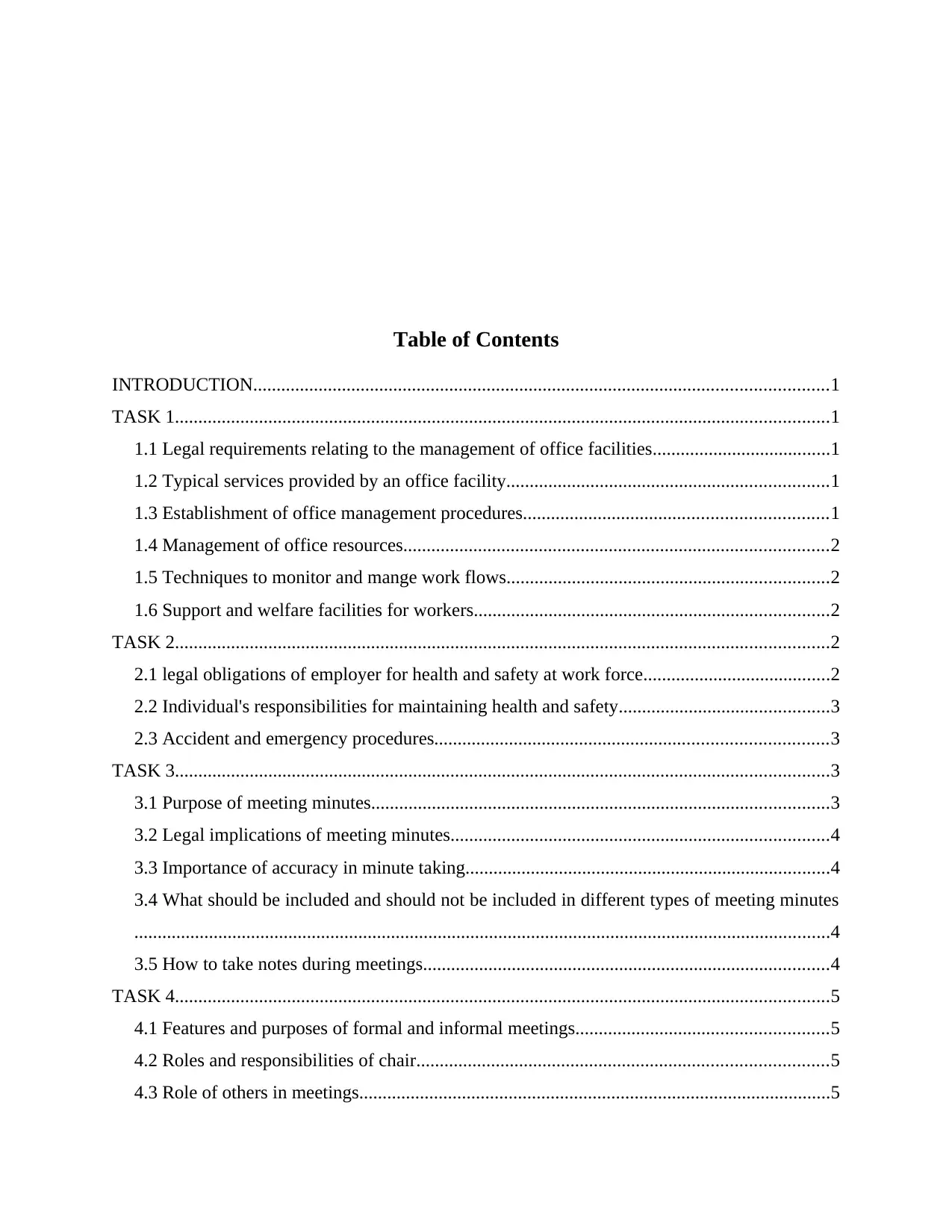
Table of Contents
INTRODUCTION...........................................................................................................................1
TASK 1............................................................................................................................................1
1.1 Legal requirements relating to the management of office facilities......................................1
1.2 Typical services provided by an office facility.....................................................................1
1.3 Establishment of office management procedures.................................................................1
1.4 Management of office resources...........................................................................................2
1.5 Techniques to monitor and mange work flows.....................................................................2
1.6 Support and welfare facilities for workers............................................................................2
TASK 2............................................................................................................................................2
2.1 legal obligations of employer for health and safety at work force........................................2
2.2 Individual's responsibilities for maintaining health and safety.............................................3
2.3 Accident and emergency procedures....................................................................................3
TASK 3............................................................................................................................................3
3.1 Purpose of meeting minutes..................................................................................................3
3.2 Legal implications of meeting minutes.................................................................................4
3.3 Importance of accuracy in minute taking..............................................................................4
3.4 What should be included and should not be included in different types of meeting minutes
.....................................................................................................................................................4
3.5 How to take notes during meetings.......................................................................................4
TASK 4............................................................................................................................................5
4.1 Features and purposes of formal and informal meetings......................................................5
4.2 Roles and responsibilities of chair........................................................................................5
4.3 Role of others in meetings.....................................................................................................5
INTRODUCTION...........................................................................................................................1
TASK 1............................................................................................................................................1
1.1 Legal requirements relating to the management of office facilities......................................1
1.2 Typical services provided by an office facility.....................................................................1
1.3 Establishment of office management procedures.................................................................1
1.4 Management of office resources...........................................................................................2
1.5 Techniques to monitor and mange work flows.....................................................................2
1.6 Support and welfare facilities for workers............................................................................2
TASK 2............................................................................................................................................2
2.1 legal obligations of employer for health and safety at work force........................................2
2.2 Individual's responsibilities for maintaining health and safety.............................................3
2.3 Accident and emergency procedures....................................................................................3
TASK 3............................................................................................................................................3
3.1 Purpose of meeting minutes..................................................................................................3
3.2 Legal implications of meeting minutes.................................................................................4
3.3 Importance of accuracy in minute taking..............................................................................4
3.4 What should be included and should not be included in different types of meeting minutes
.....................................................................................................................................................4
3.5 How to take notes during meetings.......................................................................................4
TASK 4............................................................................................................................................5
4.1 Features and purposes of formal and informal meetings......................................................5
4.2 Roles and responsibilities of chair........................................................................................5
4.3 Role of others in meetings.....................................................................................................5
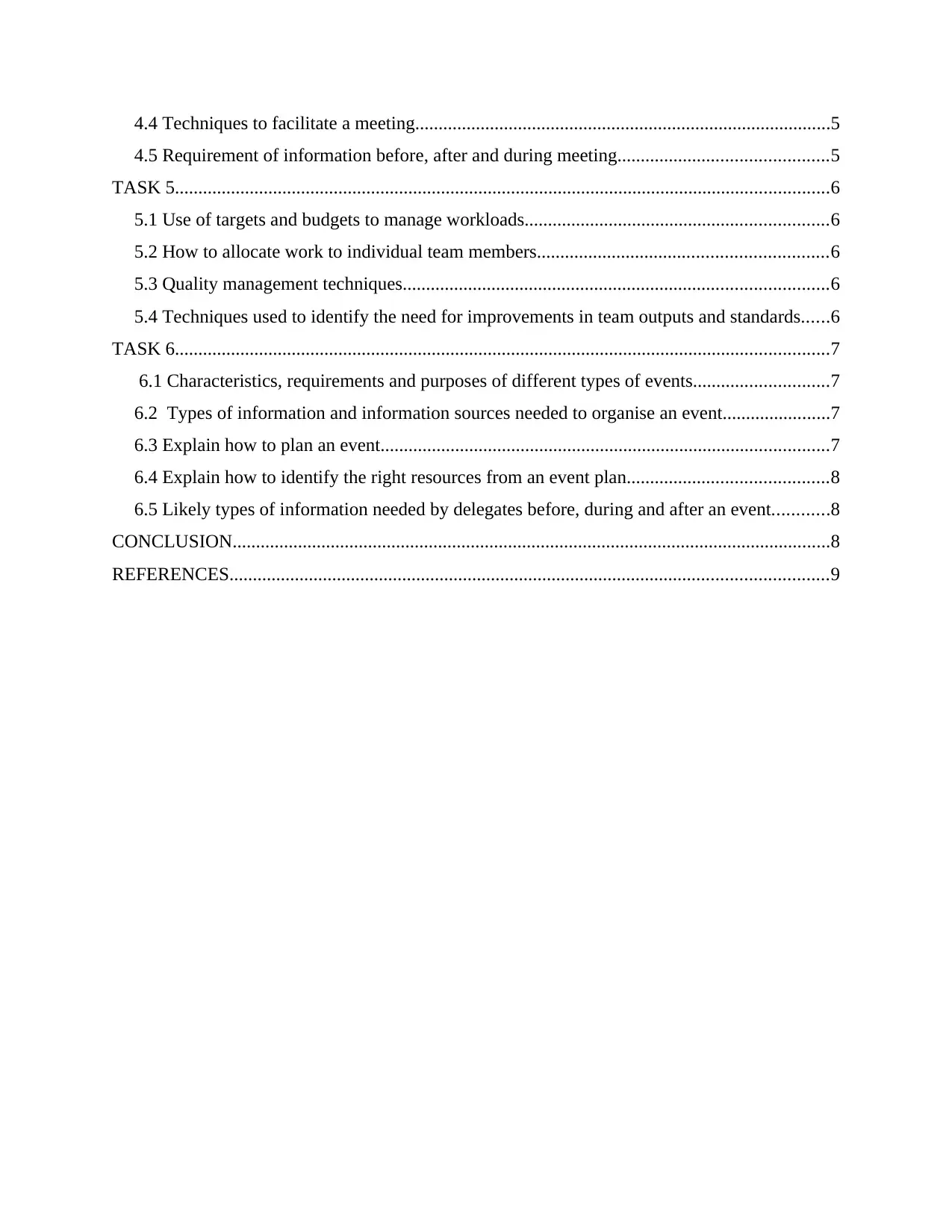
4.4 Techniques to facilitate a meeting.........................................................................................5
4.5 Requirement of information before, after and during meeting.............................................5
TASK 5............................................................................................................................................6
5.1 Use of targets and budgets to manage workloads.................................................................6
5.2 How to allocate work to individual team members..............................................................6
5.3 Quality management techniques...........................................................................................6
5.4 Techniques used to identify the need for improvements in team outputs and standards......6
TASK 6............................................................................................................................................7
6.1 Characteristics, requirements and purposes of different types of events.............................7
6.2 Types of information and information sources needed to organise an event.......................7
6.3 Explain how to plan an event................................................................................................7
6.4 Explain how to identify the right resources from an event plan...........................................8
6.5 Likely types of information needed by delegates before, during and after an event............8
CONCLUSION................................................................................................................................8
REFERENCES................................................................................................................................9
4.5 Requirement of information before, after and during meeting.............................................5
TASK 5............................................................................................................................................6
5.1 Use of targets and budgets to manage workloads.................................................................6
5.2 How to allocate work to individual team members..............................................................6
5.3 Quality management techniques...........................................................................................6
5.4 Techniques used to identify the need for improvements in team outputs and standards......6
TASK 6............................................................................................................................................7
6.1 Characteristics, requirements and purposes of different types of events.............................7
6.2 Types of information and information sources needed to organise an event.......................7
6.3 Explain how to plan an event................................................................................................7
6.4 Explain how to identify the right resources from an event plan...........................................8
6.5 Likely types of information needed by delegates before, during and after an event............8
CONCLUSION................................................................................................................................8
REFERENCES................................................................................................................................9
⊘ This is a preview!⊘
Do you want full access?
Subscribe today to unlock all pages.

Trusted by 1+ million students worldwide

Paraphrase This Document
Need a fresh take? Get an instant paraphrase of this document with our AI Paraphraser
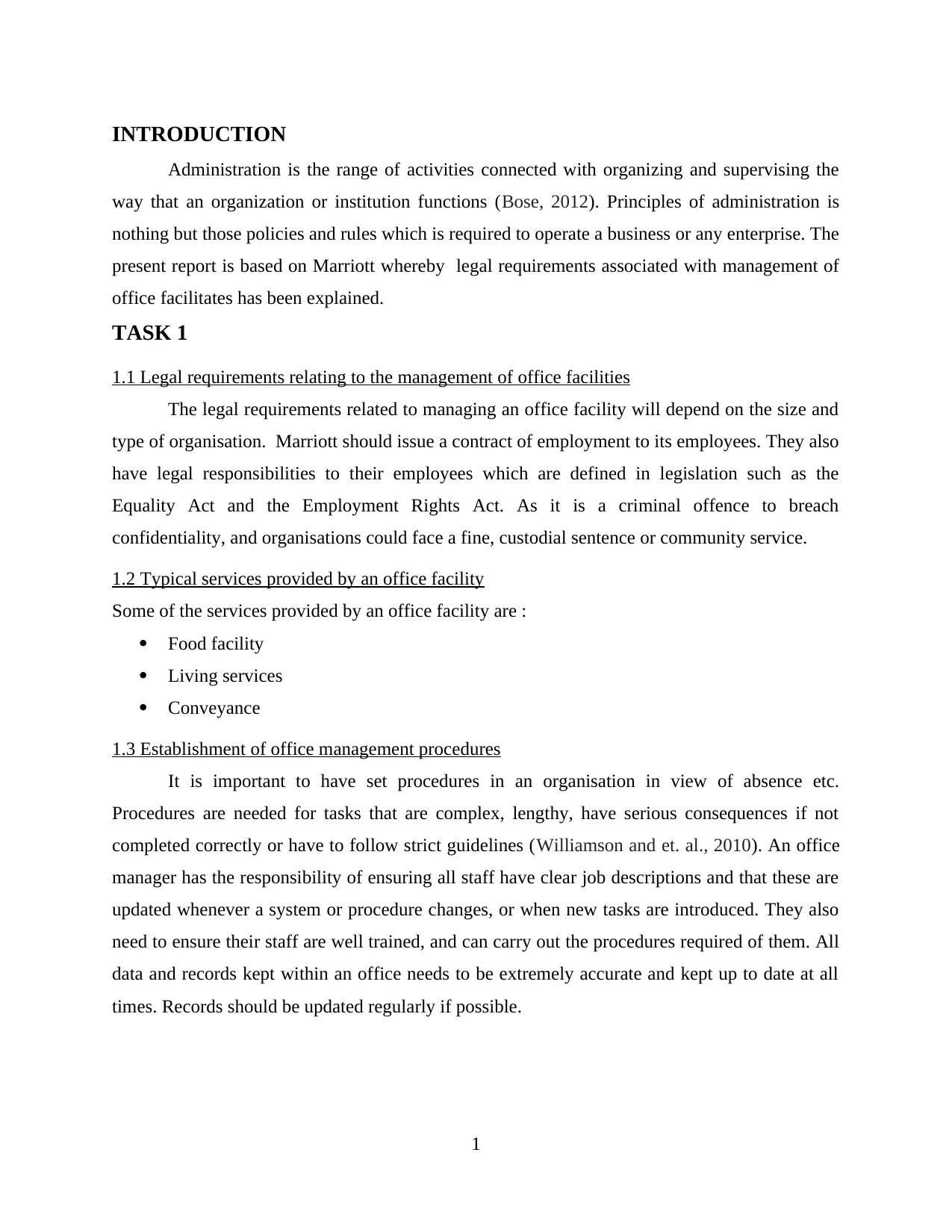
INTRODUCTION
Administration is the range of activities connected with organizing and supervising the
way that an organization or institution functions (Bose, 2012). Principles of administration is
nothing but those policies and rules which is required to operate a business or any enterprise. The
present report is based on Marriott whereby legal requirements associated with management of
office facilitates has been explained.
TASK 1
1.1 Legal requirements relating to the management of office facilities
The legal requirements related to managing an office facility will depend on the size and
type of organisation. Marriott should issue a contract of employment to its employees. They also
have legal responsibilities to their employees which are defined in legislation such as the
Equality Act and the Employment Rights Act. As it is a criminal offence to breach
confidentiality, and organisations could face a fine, custodial sentence or community service.
1.2 Typical services provided by an office facility
Some of the services provided by an office facility are :
Food facility
Living services
Conveyance
1.3 Establishment of office management procedures
It is important to have set procedures in an organisation in view of absence etc.
Procedures are needed for tasks that are complex, lengthy, have serious consequences if not
completed correctly or have to follow strict guidelines (Williamson and et. al., 2010). An office
manager has the responsibility of ensuring all staff have clear job descriptions and that these are
updated whenever a system or procedure changes, or when new tasks are introduced. They also
need to ensure their staff are well trained, and can carry out the procedures required of them. All
data and records kept within an office needs to be extremely accurate and kept up to date at all
times. Records should be updated regularly if possible.
1
Administration is the range of activities connected with organizing and supervising the
way that an organization or institution functions (Bose, 2012). Principles of administration is
nothing but those policies and rules which is required to operate a business or any enterprise. The
present report is based on Marriott whereby legal requirements associated with management of
office facilitates has been explained.
TASK 1
1.1 Legal requirements relating to the management of office facilities
The legal requirements related to managing an office facility will depend on the size and
type of organisation. Marriott should issue a contract of employment to its employees. They also
have legal responsibilities to their employees which are defined in legislation such as the
Equality Act and the Employment Rights Act. As it is a criminal offence to breach
confidentiality, and organisations could face a fine, custodial sentence or community service.
1.2 Typical services provided by an office facility
Some of the services provided by an office facility are :
Food facility
Living services
Conveyance
1.3 Establishment of office management procedures
It is important to have set procedures in an organisation in view of absence etc.
Procedures are needed for tasks that are complex, lengthy, have serious consequences if not
completed correctly or have to follow strict guidelines (Williamson and et. al., 2010). An office
manager has the responsibility of ensuring all staff have clear job descriptions and that these are
updated whenever a system or procedure changes, or when new tasks are introduced. They also
need to ensure their staff are well trained, and can carry out the procedures required of them. All
data and records kept within an office needs to be extremely accurate and kept up to date at all
times. Records should be updated regularly if possible.
1
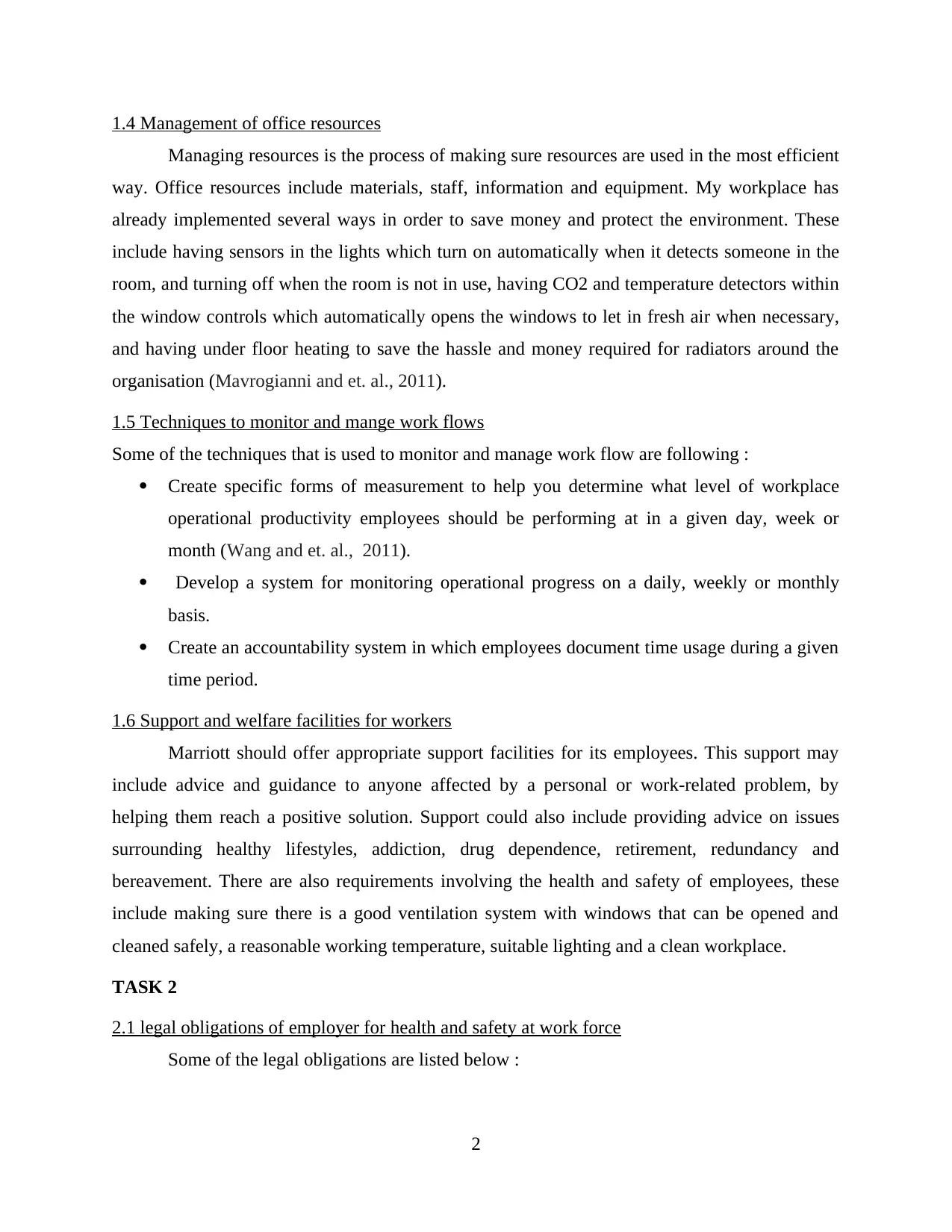
1.4 Management of office resources
Managing resources is the process of making sure resources are used in the most efficient
way. Office resources include materials, staff, information and equipment. My workplace has
already implemented several ways in order to save money and protect the environment. These
include having sensors in the lights which turn on automatically when it detects someone in the
room, and turning off when the room is not in use, having CO2 and temperature detectors within
the window controls which automatically opens the windows to let in fresh air when necessary,
and having under floor heating to save the hassle and money required for radiators around the
organisation (Mavrogianni and et. al., 2011).
1.5 Techniques to monitor and mange work flows
Some of the techniques that is used to monitor and manage work flow are following :
Create specific forms of measurement to help you determine what level of workplace
operational productivity employees should be performing at in a given day, week or
month (Wang and et. al., 2011).
Develop a system for monitoring operational progress on a daily, weekly or monthly
basis.
Create an accountability system in which employees document time usage during a given
time period.
1.6 Support and welfare facilities for workers
Marriott should offer appropriate support facilities for its employees. This support may
include advice and guidance to anyone affected by a personal or work-related problem, by
helping them reach a positive solution. Support could also include providing advice on issues
surrounding healthy lifestyles, addiction, drug dependence, retirement, redundancy and
bereavement. There are also requirements involving the health and safety of employees, these
include making sure there is a good ventilation system with windows that can be opened and
cleaned safely, a reasonable working temperature, suitable lighting and a clean workplace.
TASK 2
2.1 legal obligations of employer for health and safety at work force
Some of the legal obligations are listed below :
2
Managing resources is the process of making sure resources are used in the most efficient
way. Office resources include materials, staff, information and equipment. My workplace has
already implemented several ways in order to save money and protect the environment. These
include having sensors in the lights which turn on automatically when it detects someone in the
room, and turning off when the room is not in use, having CO2 and temperature detectors within
the window controls which automatically opens the windows to let in fresh air when necessary,
and having under floor heating to save the hassle and money required for radiators around the
organisation (Mavrogianni and et. al., 2011).
1.5 Techniques to monitor and mange work flows
Some of the techniques that is used to monitor and manage work flow are following :
Create specific forms of measurement to help you determine what level of workplace
operational productivity employees should be performing at in a given day, week or
month (Wang and et. al., 2011).
Develop a system for monitoring operational progress on a daily, weekly or monthly
basis.
Create an accountability system in which employees document time usage during a given
time period.
1.6 Support and welfare facilities for workers
Marriott should offer appropriate support facilities for its employees. This support may
include advice and guidance to anyone affected by a personal or work-related problem, by
helping them reach a positive solution. Support could also include providing advice on issues
surrounding healthy lifestyles, addiction, drug dependence, retirement, redundancy and
bereavement. There are also requirements involving the health and safety of employees, these
include making sure there is a good ventilation system with windows that can be opened and
cleaned safely, a reasonable working temperature, suitable lighting and a clean workplace.
TASK 2
2.1 legal obligations of employer for health and safety at work force
Some of the legal obligations are listed below :
2
⊘ This is a preview!⊘
Do you want full access?
Subscribe today to unlock all pages.

Trusted by 1+ million students worldwide
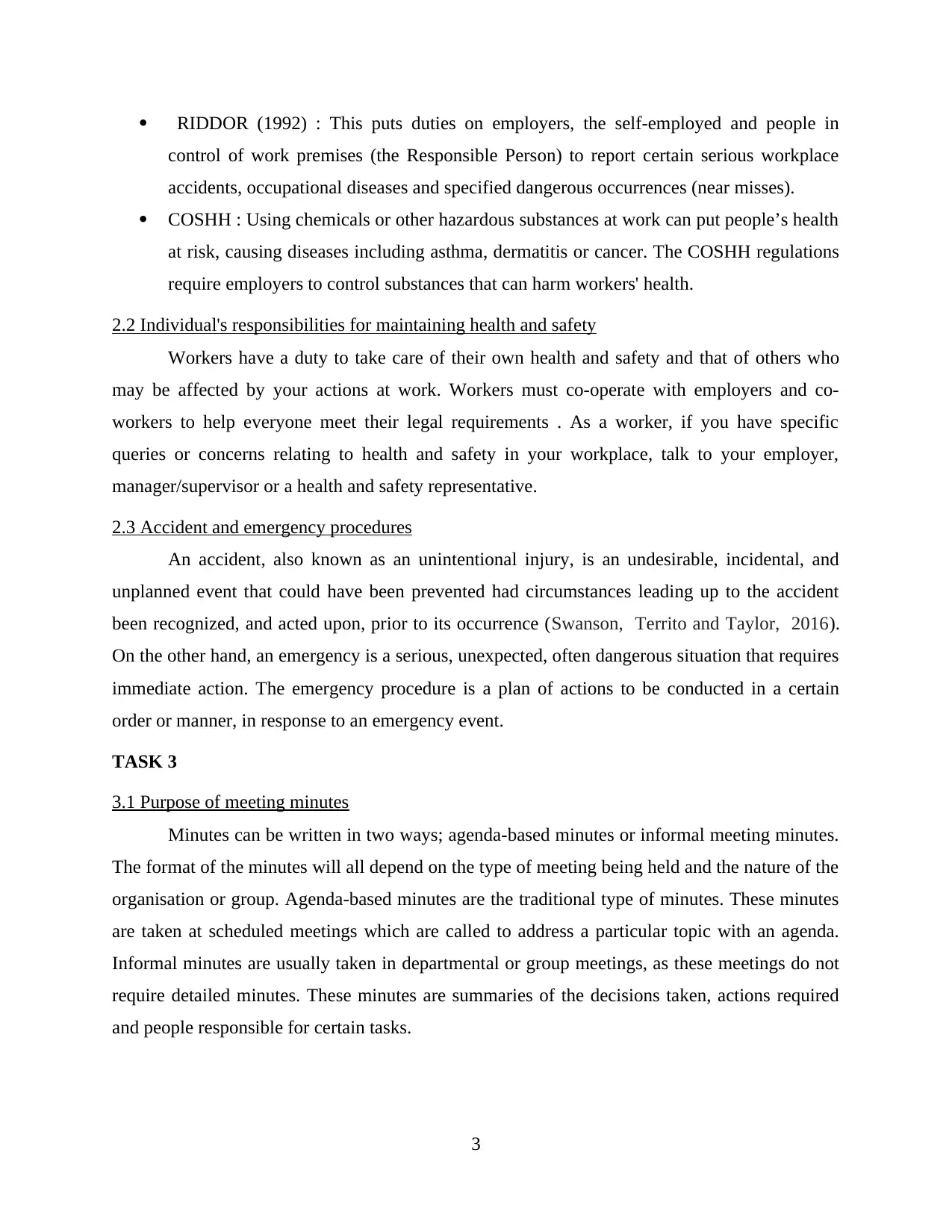
RIDDOR (1992) : This puts duties on employers, the self-employed and people in
control of work premises (the Responsible Person) to report certain serious workplace
accidents, occupational diseases and specified dangerous occurrences (near misses).
COSHH : Using chemicals or other hazardous substances at work can put people’s health
at risk, causing diseases including asthma, dermatitis or cancer. The COSHH regulations
require employers to control substances that can harm workers' health.
2.2 Individual's responsibilities for maintaining health and safety
Workers have a duty to take care of their own health and safety and that of others who
may be affected by your actions at work. Workers must co-operate with employers and co-
workers to help everyone meet their legal requirements . As a worker, if you have specific
queries or concerns relating to health and safety in your workplace, talk to your employer,
manager/supervisor or a health and safety representative.
2.3 Accident and emergency procedures
An accident, also known as an unintentional injury, is an undesirable, incidental, and
unplanned event that could have been prevented had circumstances leading up to the accident
been recognized, and acted upon, prior to its occurrence (Swanson, Territo and Taylor, 2016).
On the other hand, an emergency is a serious, unexpected, often dangerous situation that requires
immediate action. The emergency procedure is a plan of actions to be conducted in a certain
order or manner, in response to an emergency event.
TASK 3
3.1 Purpose of meeting minutes
Minutes can be written in two ways; agenda-based minutes or informal meeting minutes.
The format of the minutes will all depend on the type of meeting being held and the nature of the
organisation or group. Agenda-based minutes are the traditional type of minutes. These minutes
are taken at scheduled meetings which are called to address a particular topic with an agenda.
Informal minutes are usually taken in departmental or group meetings, as these meetings do not
require detailed minutes. These minutes are summaries of the decisions taken, actions required
and people responsible for certain tasks.
3
control of work premises (the Responsible Person) to report certain serious workplace
accidents, occupational diseases and specified dangerous occurrences (near misses).
COSHH : Using chemicals or other hazardous substances at work can put people’s health
at risk, causing diseases including asthma, dermatitis or cancer. The COSHH regulations
require employers to control substances that can harm workers' health.
2.2 Individual's responsibilities for maintaining health and safety
Workers have a duty to take care of their own health and safety and that of others who
may be affected by your actions at work. Workers must co-operate with employers and co-
workers to help everyone meet their legal requirements . As a worker, if you have specific
queries or concerns relating to health and safety in your workplace, talk to your employer,
manager/supervisor or a health and safety representative.
2.3 Accident and emergency procedures
An accident, also known as an unintentional injury, is an undesirable, incidental, and
unplanned event that could have been prevented had circumstances leading up to the accident
been recognized, and acted upon, prior to its occurrence (Swanson, Territo and Taylor, 2016).
On the other hand, an emergency is a serious, unexpected, often dangerous situation that requires
immediate action. The emergency procedure is a plan of actions to be conducted in a certain
order or manner, in response to an emergency event.
TASK 3
3.1 Purpose of meeting minutes
Minutes can be written in two ways; agenda-based minutes or informal meeting minutes.
The format of the minutes will all depend on the type of meeting being held and the nature of the
organisation or group. Agenda-based minutes are the traditional type of minutes. These minutes
are taken at scheduled meetings which are called to address a particular topic with an agenda.
Informal minutes are usually taken in departmental or group meetings, as these meetings do not
require detailed minutes. These minutes are summaries of the decisions taken, actions required
and people responsible for certain tasks.
3
Paraphrase This Document
Need a fresh take? Get an instant paraphrase of this document with our AI Paraphraser
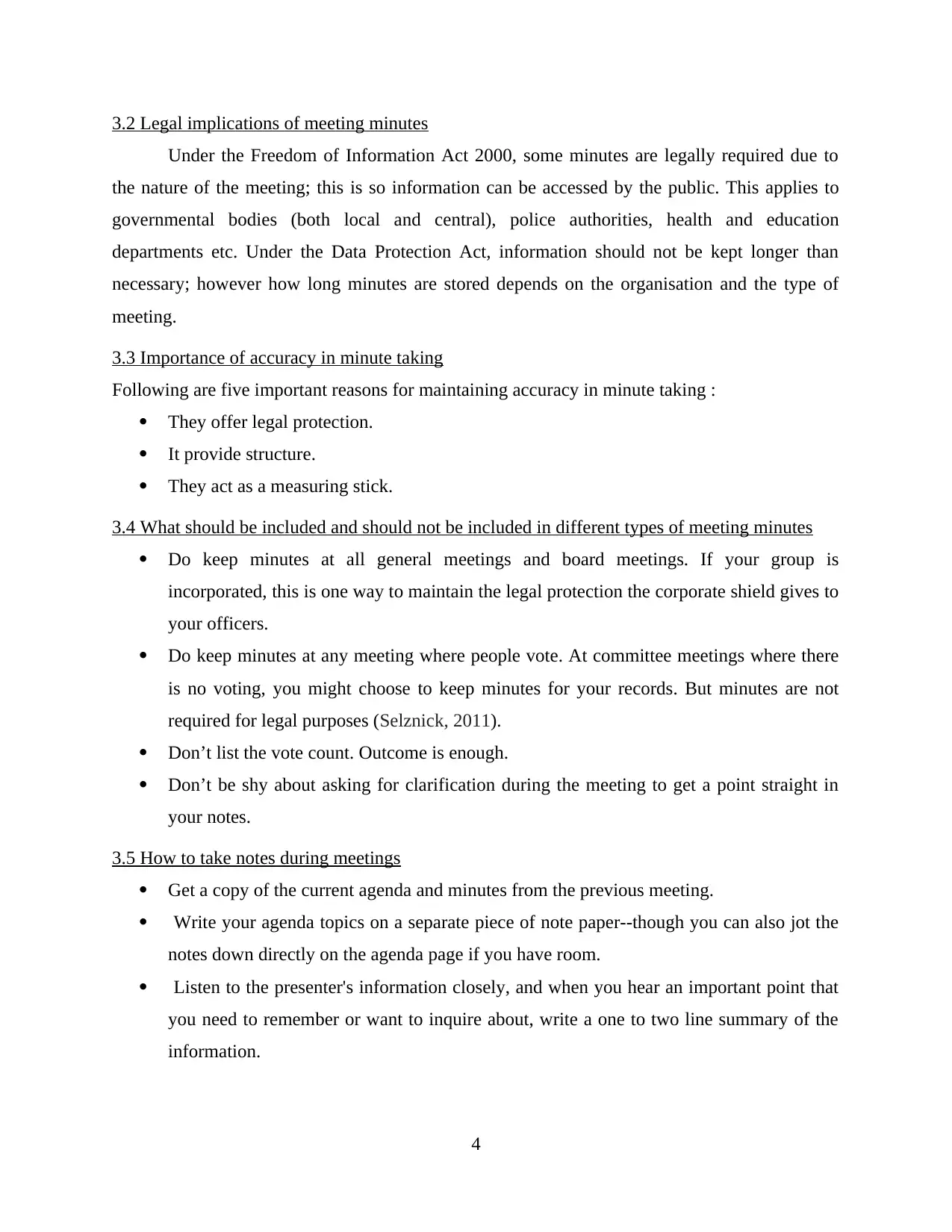
3.2 Legal implications of meeting minutes
Under the Freedom of Information Act 2000, some minutes are legally required due to
the nature of the meeting; this is so information can be accessed by the public. This applies to
governmental bodies (both local and central), police authorities, health and education
departments etc. Under the Data Protection Act, information should not be kept longer than
necessary; however how long minutes are stored depends on the organisation and the type of
meeting.
3.3 Importance of accuracy in minute taking
Following are five important reasons for maintaining accuracy in minute taking :
They offer legal protection.
It provide structure.
They act as a measuring stick.
3.4 What should be included and should not be included in different types of meeting minutes
Do keep minutes at all general meetings and board meetings. If your group is
incorporated, this is one way to maintain the legal protection the corporate shield gives to
your officers.
Do keep minutes at any meeting where people vote. At committee meetings where there
is no voting, you might choose to keep minutes for your records. But minutes are not
required for legal purposes (Selznick, 2011).
Don’t list the vote count. Outcome is enough.
Don’t be shy about asking for clarification during the meeting to get a point straight in
your notes.
3.5 How to take notes during meetings
Get a copy of the current agenda and minutes from the previous meeting.
Write your agenda topics on a separate piece of note paper--though you can also jot the
notes down directly on the agenda page if you have room.
Listen to the presenter's information closely, and when you hear an important point that
you need to remember or want to inquire about, write a one to two line summary of the
information.
4
Under the Freedom of Information Act 2000, some minutes are legally required due to
the nature of the meeting; this is so information can be accessed by the public. This applies to
governmental bodies (both local and central), police authorities, health and education
departments etc. Under the Data Protection Act, information should not be kept longer than
necessary; however how long minutes are stored depends on the organisation and the type of
meeting.
3.3 Importance of accuracy in minute taking
Following are five important reasons for maintaining accuracy in minute taking :
They offer legal protection.
It provide structure.
They act as a measuring stick.
3.4 What should be included and should not be included in different types of meeting minutes
Do keep minutes at all general meetings and board meetings. If your group is
incorporated, this is one way to maintain the legal protection the corporate shield gives to
your officers.
Do keep minutes at any meeting where people vote. At committee meetings where there
is no voting, you might choose to keep minutes for your records. But minutes are not
required for legal purposes (Selznick, 2011).
Don’t list the vote count. Outcome is enough.
Don’t be shy about asking for clarification during the meeting to get a point straight in
your notes.
3.5 How to take notes during meetings
Get a copy of the current agenda and minutes from the previous meeting.
Write your agenda topics on a separate piece of note paper--though you can also jot the
notes down directly on the agenda page if you have room.
Listen to the presenter's information closely, and when you hear an important point that
you need to remember or want to inquire about, write a one to two line summary of the
information.
4
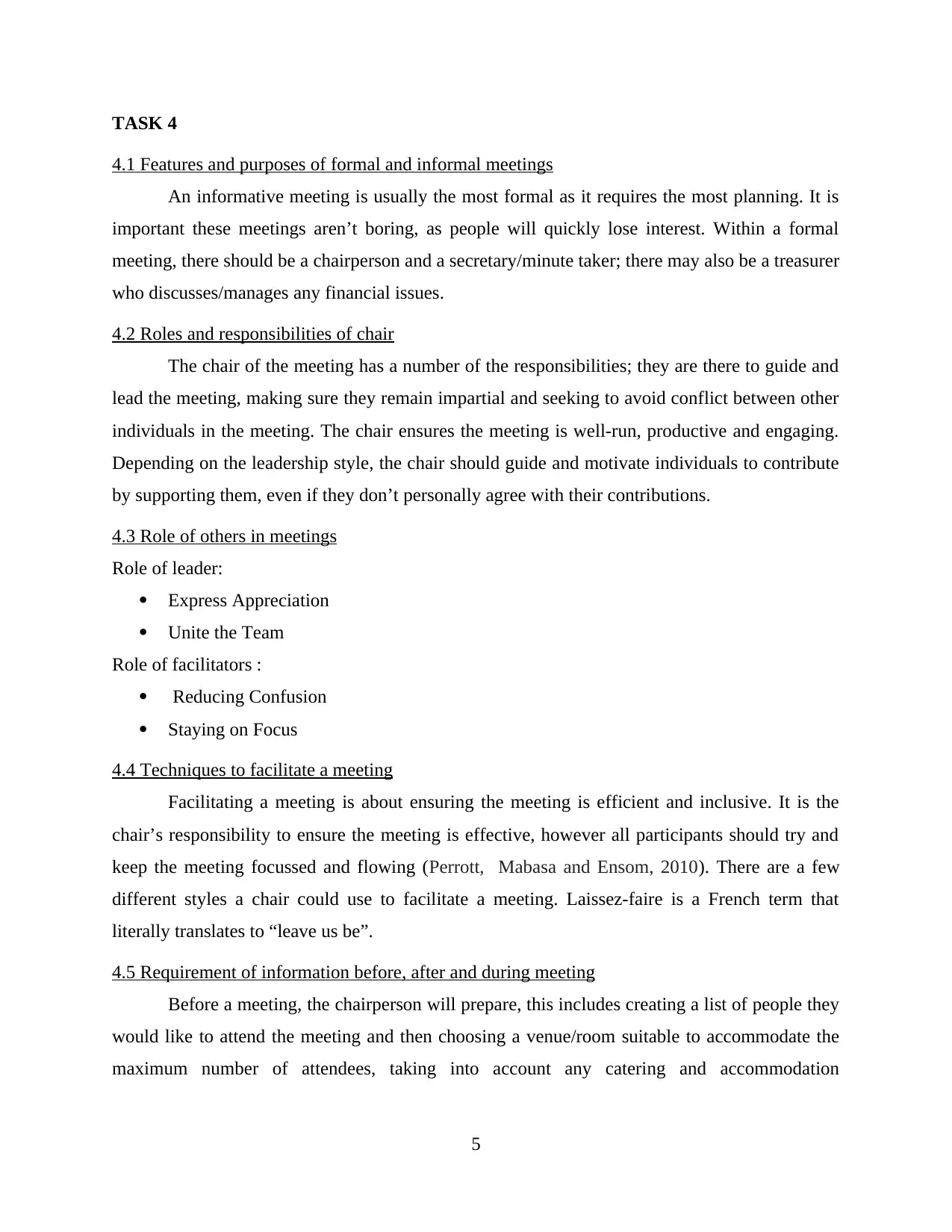
TASK 4
4.1 Features and purposes of formal and informal meetings
An informative meeting is usually the most formal as it requires the most planning. It is
important these meetings aren’t boring, as people will quickly lose interest. Within a formal
meeting, there should be a chairperson and a secretary/minute taker; there may also be a treasurer
who discusses/manages any financial issues.
4.2 Roles and responsibilities of chair
The chair of the meeting has a number of the responsibilities; they are there to guide and
lead the meeting, making sure they remain impartial and seeking to avoid conflict between other
individuals in the meeting. The chair ensures the meeting is well-run, productive and engaging.
Depending on the leadership style, the chair should guide and motivate individuals to contribute
by supporting them, even if they don’t personally agree with their contributions.
4.3 Role of others in meetings
Role of leader:
Express Appreciation
Unite the Team
Role of facilitators :
Reducing Confusion
Staying on Focus
4.4 Techniques to facilitate a meeting
Facilitating a meeting is about ensuring the meeting is efficient and inclusive. It is the
chair’s responsibility to ensure the meeting is effective, however all participants should try and
keep the meeting focussed and flowing (Perrott, Mabasa and Ensom, 2010). There are a few
different styles a chair could use to facilitate a meeting. Laissez-faire is a French term that
literally translates to “leave us be”.
4.5 Requirement of information before, after and during meeting
Before a meeting, the chairperson will prepare, this includes creating a list of people they
would like to attend the meeting and then choosing a venue/room suitable to accommodate the
maximum number of attendees, taking into account any catering and accommodation
5
4.1 Features and purposes of formal and informal meetings
An informative meeting is usually the most formal as it requires the most planning. It is
important these meetings aren’t boring, as people will quickly lose interest. Within a formal
meeting, there should be a chairperson and a secretary/minute taker; there may also be a treasurer
who discusses/manages any financial issues.
4.2 Roles and responsibilities of chair
The chair of the meeting has a number of the responsibilities; they are there to guide and
lead the meeting, making sure they remain impartial and seeking to avoid conflict between other
individuals in the meeting. The chair ensures the meeting is well-run, productive and engaging.
Depending on the leadership style, the chair should guide and motivate individuals to contribute
by supporting them, even if they don’t personally agree with their contributions.
4.3 Role of others in meetings
Role of leader:
Express Appreciation
Unite the Team
Role of facilitators :
Reducing Confusion
Staying on Focus
4.4 Techniques to facilitate a meeting
Facilitating a meeting is about ensuring the meeting is efficient and inclusive. It is the
chair’s responsibility to ensure the meeting is effective, however all participants should try and
keep the meeting focussed and flowing (Perrott, Mabasa and Ensom, 2010). There are a few
different styles a chair could use to facilitate a meeting. Laissez-faire is a French term that
literally translates to “leave us be”.
4.5 Requirement of information before, after and during meeting
Before a meeting, the chairperson will prepare, this includes creating a list of people they
would like to attend the meeting and then choosing a venue/room suitable to accommodate the
maximum number of attendees, taking into account any catering and accommodation
5
⊘ This is a preview!⊘
Do you want full access?
Subscribe today to unlock all pages.

Trusted by 1+ million students worldwide
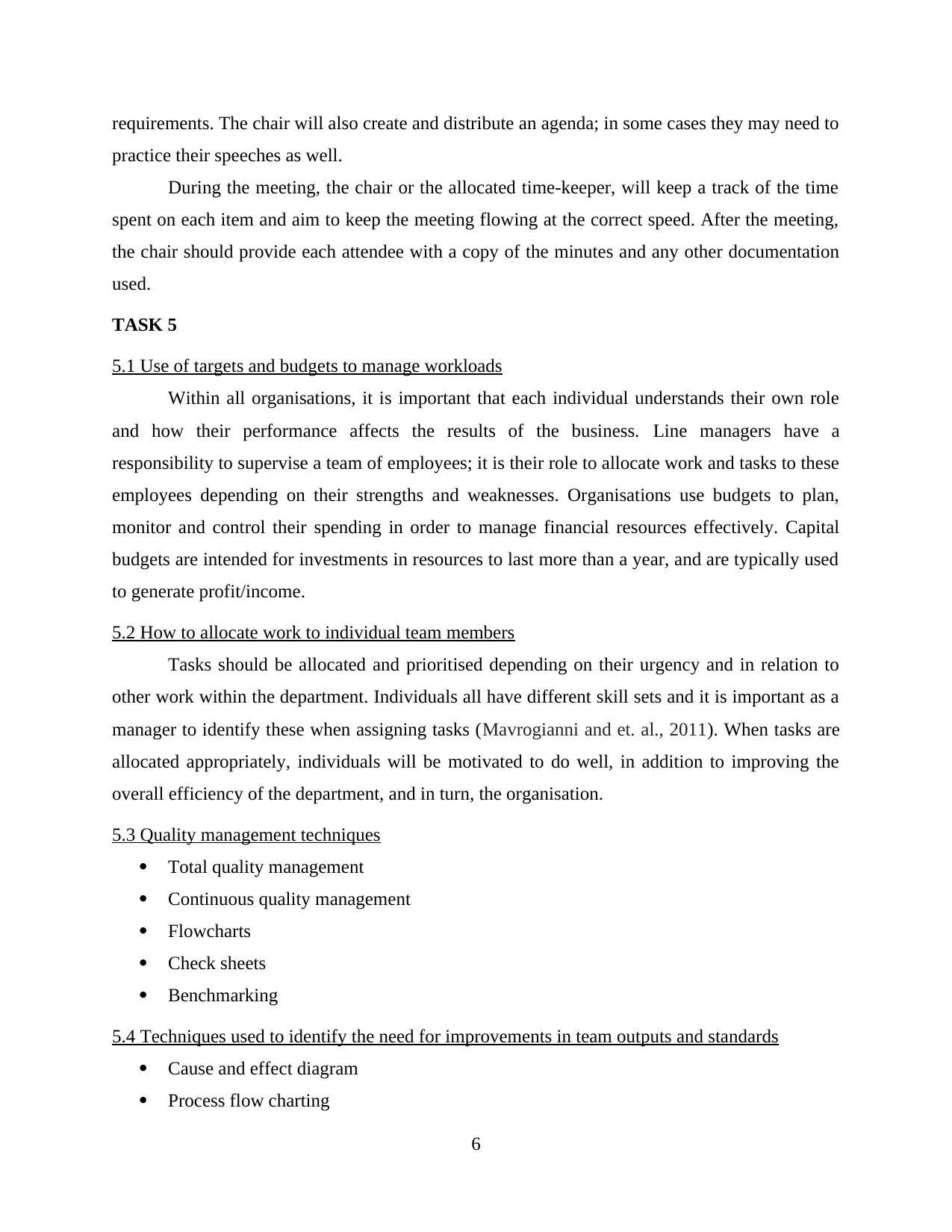
requirements. The chair will also create and distribute an agenda; in some cases they may need to
practice their speeches as well.
During the meeting, the chair or the allocated time-keeper, will keep a track of the time
spent on each item and aim to keep the meeting flowing at the correct speed. After the meeting,
the chair should provide each attendee with a copy of the minutes and any other documentation
used.
TASK 5
5.1 Use of targets and budgets to manage workloads
Within all organisations, it is important that each individual understands their own role
and how their performance affects the results of the business. Line managers have a
responsibility to supervise a team of employees; it is their role to allocate work and tasks to these
employees depending on their strengths and weaknesses. Organisations use budgets to plan,
monitor and control their spending in order to manage financial resources effectively. Capital
budgets are intended for investments in resources to last more than a year, and are typically used
to generate profit/income.
5.2 How to allocate work to individual team members
Tasks should be allocated and prioritised depending on their urgency and in relation to
other work within the department. Individuals all have different skill sets and it is important as a
manager to identify these when assigning tasks (Mavrogianni and et. al., 2011). When tasks are
allocated appropriately, individuals will be motivated to do well, in addition to improving the
overall efficiency of the department, and in turn, the organisation.
5.3 Quality management techniques
Total quality management
Continuous quality management
Flowcharts
Check sheets
Benchmarking
5.4 Techniques used to identify the need for improvements in team outputs and standards
Cause and effect diagram
Process flow charting
6
practice their speeches as well.
During the meeting, the chair or the allocated time-keeper, will keep a track of the time
spent on each item and aim to keep the meeting flowing at the correct speed. After the meeting,
the chair should provide each attendee with a copy of the minutes and any other documentation
used.
TASK 5
5.1 Use of targets and budgets to manage workloads
Within all organisations, it is important that each individual understands their own role
and how their performance affects the results of the business. Line managers have a
responsibility to supervise a team of employees; it is their role to allocate work and tasks to these
employees depending on their strengths and weaknesses. Organisations use budgets to plan,
monitor and control their spending in order to manage financial resources effectively. Capital
budgets are intended for investments in resources to last more than a year, and are typically used
to generate profit/income.
5.2 How to allocate work to individual team members
Tasks should be allocated and prioritised depending on their urgency and in relation to
other work within the department. Individuals all have different skill sets and it is important as a
manager to identify these when assigning tasks (Mavrogianni and et. al., 2011). When tasks are
allocated appropriately, individuals will be motivated to do well, in addition to improving the
overall efficiency of the department, and in turn, the organisation.
5.3 Quality management techniques
Total quality management
Continuous quality management
Flowcharts
Check sheets
Benchmarking
5.4 Techniques used to identify the need for improvements in team outputs and standards
Cause and effect diagram
Process flow charting
6
Paraphrase This Document
Need a fresh take? Get an instant paraphrase of this document with our AI Paraphraser
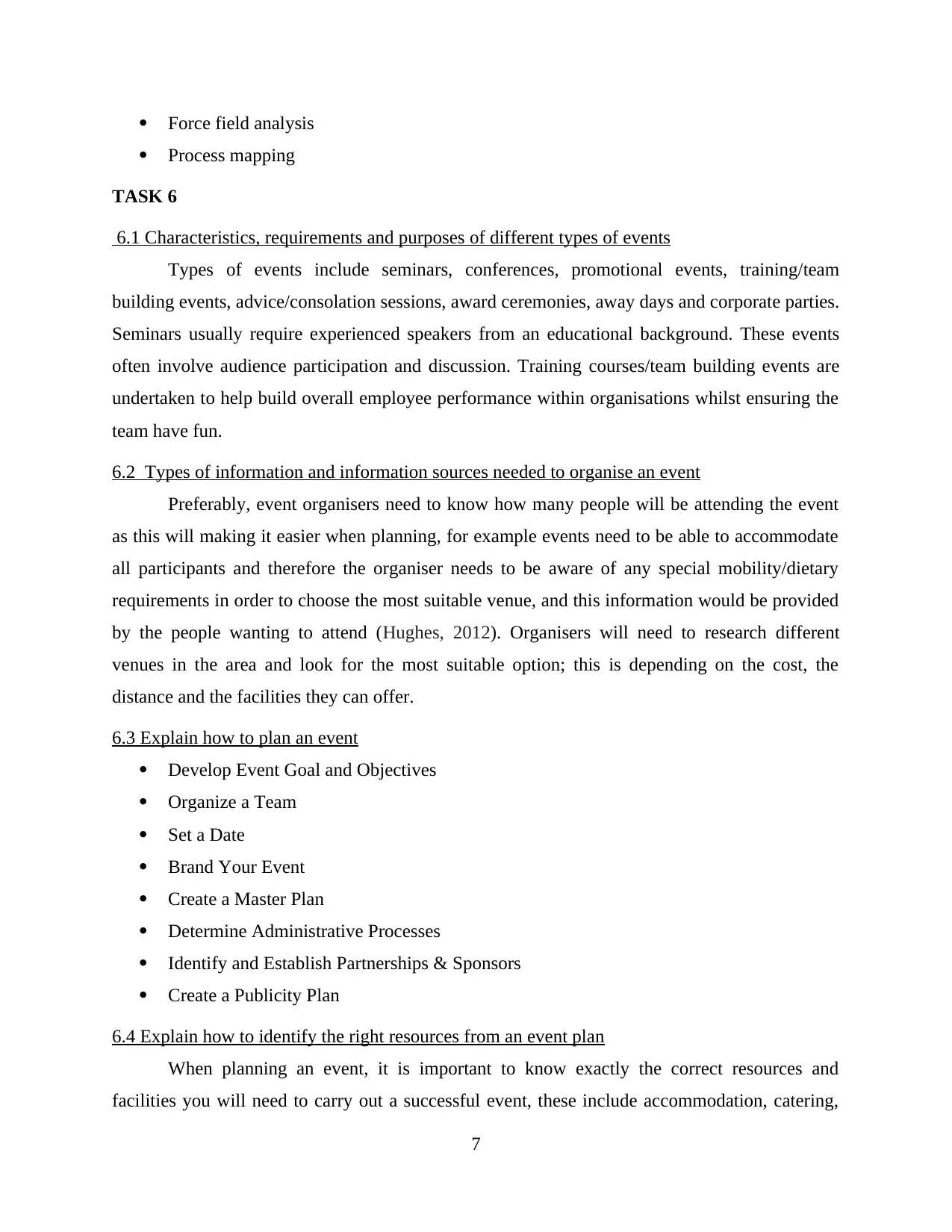
Force field analysis
Process mapping
TASK 6
6.1 Characteristics, requirements and purposes of different types of events
Types of events include seminars, conferences, promotional events, training/team
building events, advice/consolation sessions, award ceremonies, away days and corporate parties.
Seminars usually require experienced speakers from an educational background. These events
often involve audience participation and discussion. Training courses/team building events are
undertaken to help build overall employee performance within organisations whilst ensuring the
team have fun.
6.2 Types of information and information sources needed to organise an event
Preferably, event organisers need to know how many people will be attending the event
as this will making it easier when planning, for example events need to be able to accommodate
all participants and therefore the organiser needs to be aware of any special mobility/dietary
requirements in order to choose the most suitable venue, and this information would be provided
by the people wanting to attend (Hughes, 2012). Organisers will need to research different
venues in the area and look for the most suitable option; this is depending on the cost, the
distance and the facilities they can offer.
6.3 Explain how to plan an event
Develop Event Goal and Objectives
Organize a Team
Set a Date
Brand Your Event
Create a Master Plan
Determine Administrative Processes
Identify and Establish Partnerships & Sponsors
Create a Publicity Plan
6.4 Explain how to identify the right resources from an event plan
When planning an event, it is important to know exactly the correct resources and
facilities you will need to carry out a successful event, these include accommodation, catering,
7
Process mapping
TASK 6
6.1 Characteristics, requirements and purposes of different types of events
Types of events include seminars, conferences, promotional events, training/team
building events, advice/consolation sessions, award ceremonies, away days and corporate parties.
Seminars usually require experienced speakers from an educational background. These events
often involve audience participation and discussion. Training courses/team building events are
undertaken to help build overall employee performance within organisations whilst ensuring the
team have fun.
6.2 Types of information and information sources needed to organise an event
Preferably, event organisers need to know how many people will be attending the event
as this will making it easier when planning, for example events need to be able to accommodate
all participants and therefore the organiser needs to be aware of any special mobility/dietary
requirements in order to choose the most suitable venue, and this information would be provided
by the people wanting to attend (Hughes, 2012). Organisers will need to research different
venues in the area and look for the most suitable option; this is depending on the cost, the
distance and the facilities they can offer.
6.3 Explain how to plan an event
Develop Event Goal and Objectives
Organize a Team
Set a Date
Brand Your Event
Create a Master Plan
Determine Administrative Processes
Identify and Establish Partnerships & Sponsors
Create a Publicity Plan
6.4 Explain how to identify the right resources from an event plan
When planning an event, it is important to know exactly the correct resources and
facilities you will need to carry out a successful event, these include accommodation, catering,
7
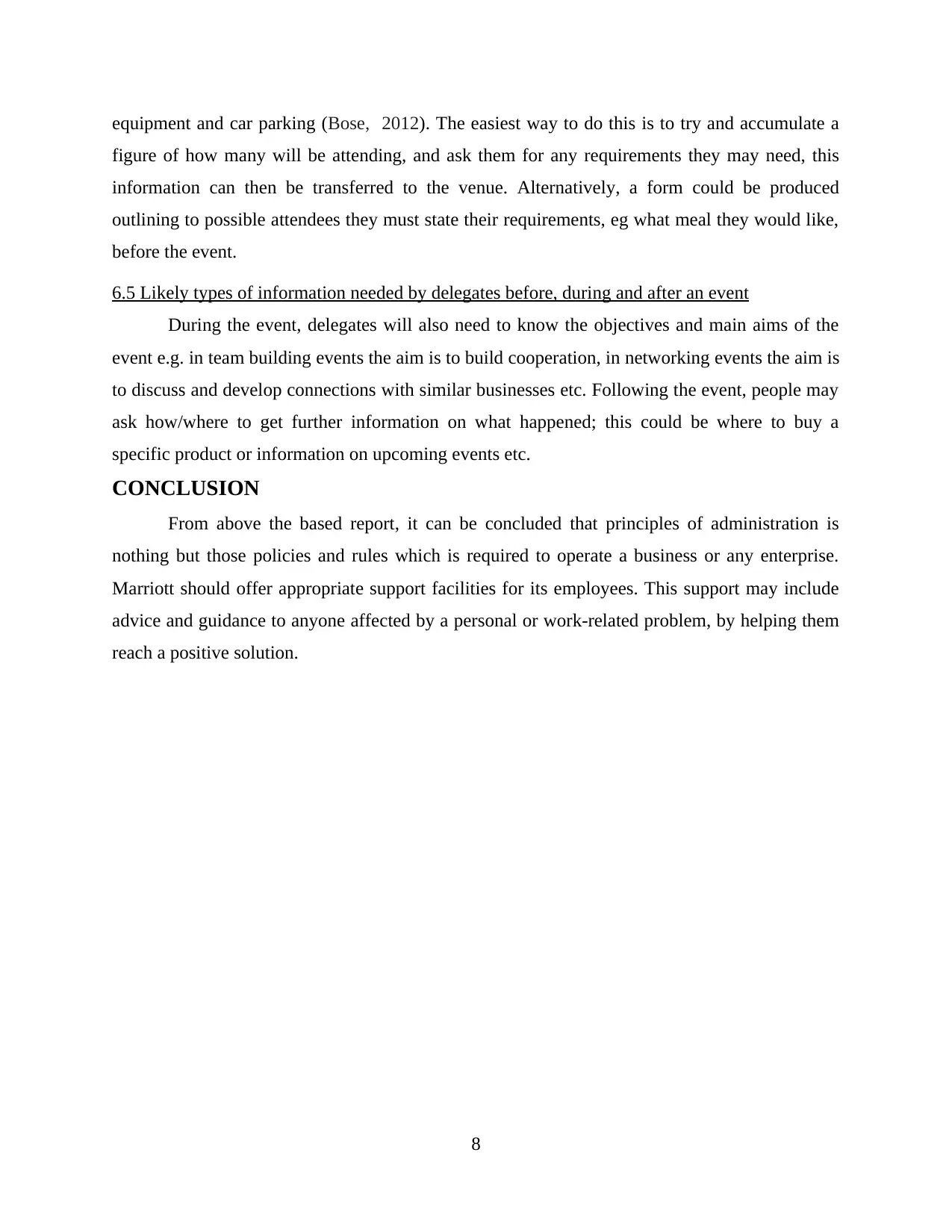
equipment and car parking (Bose, 2012). The easiest way to do this is to try and accumulate a
figure of how many will be attending, and ask them for any requirements they may need, this
information can then be transferred to the venue. Alternatively, a form could be produced
outlining to possible attendees they must state their requirements, eg what meal they would like,
before the event.
6.5 Likely types of information needed by delegates before, during and after an event
During the event, delegates will also need to know the objectives and main aims of the
event e.g. in team building events the aim is to build cooperation, in networking events the aim is
to discuss and develop connections with similar businesses etc. Following the event, people may
ask how/where to get further information on what happened; this could be where to buy a
specific product or information on upcoming events etc.
CONCLUSION
From above the based report, it can be concluded that principles of administration is
nothing but those policies and rules which is required to operate a business or any enterprise.
Marriott should offer appropriate support facilities for its employees. This support may include
advice and guidance to anyone affected by a personal or work-related problem, by helping them
reach a positive solution.
8
figure of how many will be attending, and ask them for any requirements they may need, this
information can then be transferred to the venue. Alternatively, a form could be produced
outlining to possible attendees they must state their requirements, eg what meal they would like,
before the event.
6.5 Likely types of information needed by delegates before, during and after an event
During the event, delegates will also need to know the objectives and main aims of the
event e.g. in team building events the aim is to build cooperation, in networking events the aim is
to discuss and develop connections with similar businesses etc. Following the event, people may
ask how/where to get further information on what happened; this could be where to buy a
specific product or information on upcoming events etc.
CONCLUSION
From above the based report, it can be concluded that principles of administration is
nothing but those policies and rules which is required to operate a business or any enterprise.
Marriott should offer appropriate support facilities for its employees. This support may include
advice and guidance to anyone affected by a personal or work-related problem, by helping them
reach a positive solution.
8
⊘ This is a preview!⊘
Do you want full access?
Subscribe today to unlock all pages.

Trusted by 1+ million students worldwide
1 out of 13
Related Documents
Your All-in-One AI-Powered Toolkit for Academic Success.
+13062052269
info@desklib.com
Available 24*7 on WhatsApp / Email
![[object Object]](/_next/static/media/star-bottom.7253800d.svg)
Unlock your academic potential
Copyright © 2020–2025 A2Z Services. All Rights Reserved. Developed and managed by ZUCOL.





